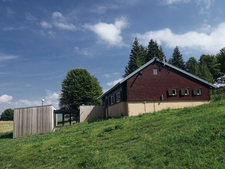-
Topics
subnavigation
Topics
Electromagnetic fields
- What are electromagnetic fields?
- Static and low-frequency fields
- Radiation protection relating to the expansion of the national grid
- High-frequency fields
- Radiation protection in mobile communication
Optical radiation
Ionising radiation
- What is ionising radiation?
- Radioactivity in the environment
- Applications in medicine
- Applications in daily life and in technology
- Effects
- What are the effects of radiation?
- Effects of selected radioactive materials
- Consequences of a radiation accident
- Cancer and leukaemia
- Genetic radiation effects
- Individual radiosensitivity
- Epidemiology of radiation-induced diseases
- Ionising radiation: positive effects?
- Risk estimation and assessment
- Radiation protection
- Nuclear accident management
- Service offers
-
The BfS
subnavigation
The BfS
- About us
- Science and research
- Laws and regulations
- BfS Topics in the Bundestag
- Links
Monitoring station Schauinsland: history and tasksmission
- Shortly after World War II (1946), a group of scientists from the Institute of Physics of the Albert-Ludwigs-University in Freiburg by Prof. Wolfgang Gentner and Dr. Albert Sittkus started to conduct experiments to characterise the cosmic radiation on Mt Schauinsland in the Black Forest.
- In spring of 1953, the researchers for the first time succeeded in detecting fallout from nuclear weapons tests in precipitation samples.
- As a result, a permanent monitoring station was established on Mt Schauinsland (1200 meters above sea level) for the continuous, long-term monitoring of the atmosphere for artificial and natural radioactivity. In 1957 the station began operation.
- Following the nuclear catastrophe at Chernobyl, the researchers and monitoring station were integrated into the newly founded Federal Office for Radiation Protection (BfS) in 1989 and the range of responsibilities was broadened to include emergency preparedness functions.
- Today the station is also part of the International Monitoring System (IMIS) for the verification of the Comprehensive Nuclear-Test-Ban Treaty (CTBT) adopted by the UN.

![]() Historical measurement setup for monitoring the atmosphere for artificial radioactivity (1960s)
Historical measurement setup for monitoring the atmosphere for artificial radioactivity (1960s)
Shortly after World War II (1946), a group of scientists from the Institute of Physics of the Albert-Ludwigs-University in Freiburg led by of Prof. Wolfgang Gentner and Dr. Albert Sittkus started to conduct experiments to charaterise the cosmic radiation on Mt Schauinsland in the Black Forest.
In spring of 1953, the researchers for the first time succeeded in detecting fallout from nuclear weapons tests in precipitation samples. As a result, a permanent monitoring station was established on Mt Schauinsland (1200 meters above sea level) for the continuous, long-term monitoring of the atmosphere for artificial and natural radioactivity. In 1957 the station began operation.
In the following years, monitoring the environment for radioactive substances became more and more important due to the increasing military and civil use of nuclear energy. New methods for nuclide-specific measurements of radioactive substances bound to airborne dust and for the measurement of radioactive noble gases in air were developed. One of these systems has been in continuous operation since 1957. Up to date data are made available on the Internet on a weekly basis.
Until 1982: Freiburg-Schauinsland branch of the Max Planck Institute
Up until 1980, radioactive substances from atmospheric nuclear weapons tests were detected a number of times at the station, the last test being Lop Nor, China.
From 1958 to 1982 the monitoring station and the Freiburg laboratory, in its capacity as the "Freiburg-Schauinsland branch", was part of the Max-Planck-Institute for Nuclear Physics in Heidelberg.
As the "Institute for Atmospheric Radioactivity" (IAR), the facilities were merged into the Federal Office of Civil Defence (BZS) in 1982.
1989: The monitoring station is integrated into the newly founded BfS

![]() The Schauinsland monitoring station of the BfS with the new annexe for the RASA air sampler
The Schauinsland monitoring station of the BfS with the new annexe for the RASA air sampler
The radioactive cloud from the reactor disaster in Chernobyl was also detected at the monitoring station on Mt Schauinsland. Following the reactor disaster, the Freiburg research group and the Schauinsland station were integrated into the newly founded Federal Office for Radiation Protection (BfS) and the range of tasks was continuously extended to include the field of "emergency preparedness". This also entailed steadily increasing cooperation with other countries in the areas of
- monitoring networks,
- data exchange and
- the development of common strategies for nuclear emergencies.
The area of trace analysis was augmented by
- high airflow air samplers,
- methods for the nuclide-specific determination of trace amounts of α-, β and γ emitters in ground-level air as well as
- automatic systems for highly sensitive airborne dust and noble gas measurements.
Monitoring station integrated into national and international measuring networks
Continuous measurements - not only on Mt Schauinsland but also worldwide - have become increasingly important over the years. Today the monitoring station is integrated into national (Integrated Measurement and Information System, IMIS) and international monitoring networks (Comprehensive Nuclear-Test-Ban Treaty, CTBT, "Sparse Network" according to Art. 35/36 EURATOM).
In addition to highly sensitive monitoring equipment for trace analysis, the station has a multitude of monitoring systems used for gathering data in real time in the context of emergency preparedness.
In 2018 the monitoring station was upgraded and a new annexe was constructed to house and fulfil infrastructure and work, health and safety requirements for the installation of the automatic air sampler (RASA) to monitor the Comprehensive Nuclear-Test-Ban Treaty.
State of 2018.08.27


